There is perhaps no stretch of coastline in the world more soaked in romance than the Côte d’Azur. A playground for Europe’s swooning demimonde since the 18th century, the cluster of towns along the Mediterranean is cooled by the mistral wind, which today blows upon elegant villas, museums, and open-air cafés. If the aristocrats came for the breeze, artists like Cézanne, Matisse, and Picasso came for the light, setting up their easels facing the water and the gardens. Then writers came for the scene, most famously F. Scott Fitzgerald, a lover of the fishing village Antibes. Since 1946, actors have flocked to Cannes, another once-sleepy fishing village, for the most glamorous film festival in the world. But now the French Riviera and its capital, Nice, are open to all. One needn’t have a von in one’s name or a credit card made of metal that clinks when it’s dropped to enjoy the sun and sea. All you need is an appetite for beauty—and maybe a good pair of sunglasses.
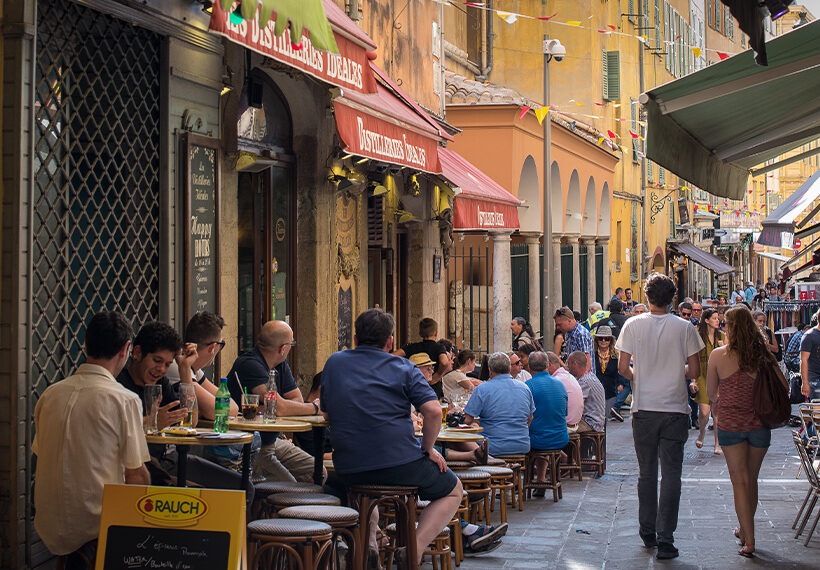
Day 1
Art, literature, and music in Nice
From a circling jet plane at night, Nice looks like a tray of jewels sitting on the water’s edge. Given my late arrival at the Hôtel Le Negresco, one of the grande dames that line the Promenade des Anglais along the sea, I have to wait until the morning to take in the city’s famous light, but it doesn’t disappoint: Dawn greets me with an embrace of color as vibrant as a Bonnard painting.
Maybe I’m just in an artist’s state of mind—it doesn’t hurt that the lobby where I grab a quick espresso is filled with pieces by Renoir and Dalí—but also, I’m traveling solo, my only companions the novelists, painters, and playwrights whose work I carry with me or encounter in this city that feels like a town. As I stroll along the Promenade des Anglais, artists are setting up their easels, disgorging their oil paints and beginning to capture the rosy pink sky over a calm, deep blue sea.
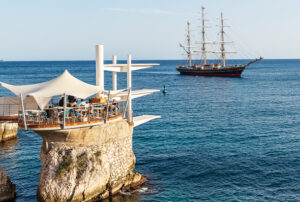
As its name suggests, the Promenade des Anglais is a long walkway and a favorite stroll for British tourists, who started frequenting the port city in the 18th century. Terns and gulls caw as I stroll, ending up at the Marché Aux Fleurs Cours Saleya, one of France’s best open-air markets. Under cheerful striped canvas shelters, farmers and florists display their wares: Brightly colored bouquets that seem caught mid-floral explosion, ripe eggplants, glistening tomatoes, and strings of garlic—a reminder that this sun-kissed corner of Europe boasts some of the continent’s best produce. The stalls look like a still life, but, of course, very little is still, as the Niçoise busily bavarder (chatter) with the vendors.
After sampling the melons (luscious), olives (Niçoise), and strawberries (plump), I stop at Librairie Masséna, a charming independent bookstore, to pick up a copy of La Promesse de l’aube (The Promise at Dawn), the 1960 autobiography of swashbuckling author Romain Gary, who emigrated to Nice from Poland as a teen. In need of a bit more sustenance, I grab a slice of socca, a maddeningly addictive chickpea flatbread typical of the Riviera, at Lou Pilha Leva, one of Nice’s historic bakeries.
From there, I make my way to MAMAC, a stunning modern art museum filled with works by Yves Klein, the founder of the Nice School, and Niki de Saint Phalle, the Franco-American artist who lived here and donated nearly 200 works to the museum. I have long been aware of Klein and his famous ultramarine blue, called International Klein Blue, but I didn’t know the connection between that hue and this place. As it turns out, one night in 1947, Klein, the painter Armand Fernandez, and the poet Claude Pascal decided to divide the world among themselves. Fernandez took the bounty of the land; Pascal got the words; and Klein chose the sky and its infinity.
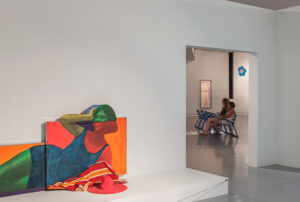
“Yves Klein wanted to show something beyond a romanticized version of the Riviera,” says Hélène Guenin, the director of MAMAC. “Instead of simply trying to copy what was going on in places like London, New York, and Paris, he wanted to do something entirely new and revolutionary.”
The soul of a city, even an artful one, isn’t found in museums alone, however, so I head back outside. The Old Town—or Vieux Nice—is a tightly woven spiral of cobblestone streets that open into charming squares with Baroque palaces or churches. Street signs are written in both French and Nissart, the local dialect derived from ancient Provençal. Second-story windows overflow with flowers, while laundry lines run from one building to another, bearing chemises like festive flags in the breeze.
Next, inspired by Klein, I head to the beach. Just under the Promenade des Anglais is a pebbly stretch of private shore occupied by very tan men and women wearing very little. Long-established companies such as Opéra Plage and new arrivistes like Le Galet offer luxurious cabanas and lounge chairs. I, however, prefer the Plage de la Réserve, a small, pebbled public beach in the port area where the locals meet to swim and enjoy a snack, and teenagers dive headlong and heedless from the steep rocks into the water below.
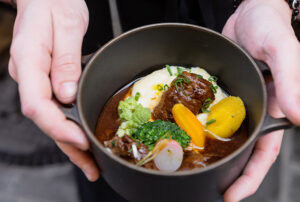
After a couple of hours of soaking up the sun, I’m famished. A friend in New York told me I had to try Bistrot d’Antoine, a very classic, very popular bistro in Old Nice; I forgot to make a reservation, but I decide to try my luck. Sophie, the austere host, informs me in slightly accented English that they are fully committed. “Maybe someone won’t show up?” I ask. She shrugs. “Peut-être.” I say I’ll wait, and I crouch in a doorway across the street, pulling out Gary’s novel to kill time.
I must look pathetic, because after a few minutes, Sophie beckons me over. “I’ll give you a table,” she says, “but only if you are gone in an hour.” Soon I’m digging into a bowl of saffron-colored mussel soup topped with crème fraîche, followed shortly by a flavorful oxtail pot-au-feu that I wash down with a glass of rosé. I’m in and out in 58 minutes.
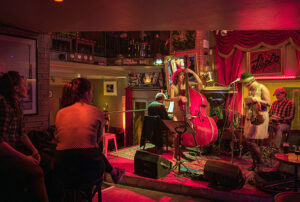
It’s still early, and I’m not ready to call it a night yet. Thankfully, the city has had a strong connection with American jazz going back to the first Nice Jazz Festival in 1948, and there are dozens of clubs to catch a show. I wander over to the intimate Shapko Bar and snag a table on the balcony. Tonight it’s not jazz, precisely, but a very good funk band called Goldfingers. Have you ever heard “Son of a Preacher Man” sung by a beautiful French woman while drinking a mauresque, a cocktail made of pastis and orgeat? You should try it. After a couple of sets, I head a few doors down to Ooh Poo Pah Doo for a Northern Soul dance party. Maybe it’s the mauresque, maybe it’s the music, maybe it’s the freedom of travel, but my inhibitions are gone, and I dance with strangers in this basement for hours. By the time I leave, the moon’s shift is nearly over. The sky is turning a brighter shade of blue as I wend my way to the sweet embrace of bed and the promise of dawn.
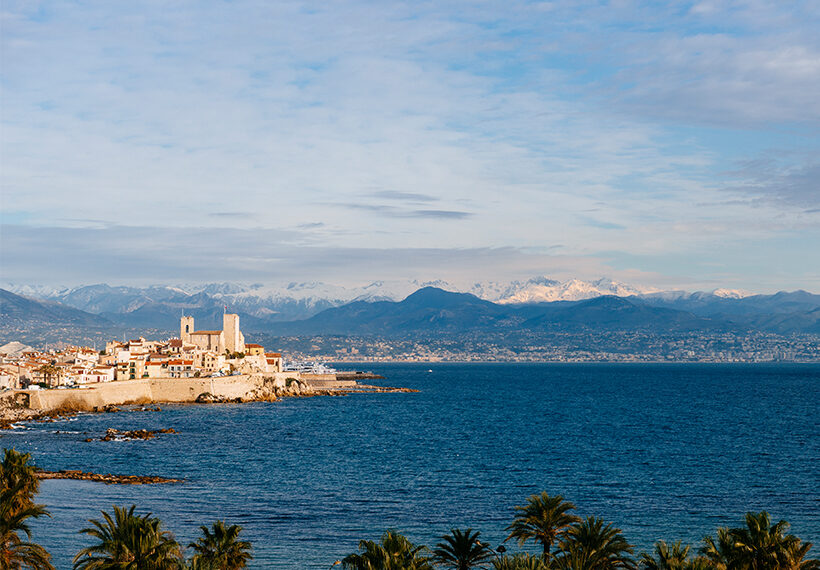
Day 2
A market feast and a coastal walk in Antibes Juan-les-Pins
Eventually, I wake up, and after the obligatory espresso and Tylenol I drive 40 minutes west to Antibes with the windows down. Like so many towns on this coast, Antibes was once a fishing village, although unlike Cannes to the west it remained sleepy until well into the 20th century. It was still a discovery, in the words of F. Scott Fitzgerald, who settled in neighboring Juan-les-Pins at the Villa Saint Louis, now the five-star Hôtel Belles Rives, where I drop my bags before heading into Antibes. I’m happy to report that what Fitzgerald described as the “diffused magic of the hot sweet South… the soft-pawed night and the ghostly wash of the Mediterranean far below” is still alive and well.
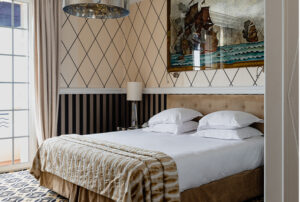
There are, I’m told, only a handful of fishermen left in Antibes. Every morning they set up shop on the Quai des Pêcheurs, just outside the medieval city walls. Today, there are just two of them, but their sea urchins, which look like spiky purple rocks, glisten—as do the fresh-caught bonito and conger eels. Standing just in front of the yacht-filled harbor, the fishermen, with their weathered jackets and faces, embody the juxtaposition of what was and what is the Riviera.
I forgo the fish for the moment and continue along to the quiet courtyard where Lilian Bonnefoi, a master chocolatier, has had his namesake pâtisserie and chocolate shop since 2015. “Chocolate,” he tells me, “is a medium that continues to evolve.” For Bonnefoi, that means local sourcing: almonds from Aix-en-Provence, figs from Grasse, and mandarins from Cannes. It’s too early for his herb-scented chocolates, but one of his buttery croissants and a detox juice are the best hangover cure I’ve ever had.
A few minutes later, I am firmly in the world of tradition at the Marché Provençal, the daily market. (Yes, I am obsessed with markets, but in the south of France you’d be a fool not to be.) This one smells of lavender, which is grown in the rolling fields just to the north and sold in sweet-smelling bundles. But there is more: Tony Toualbia sells his coppa di Corsica, figatelli, and wild boar sausage, as he has for decades. Jean-Claude Guerin stands before trays of olives harvested at his uncle’s farm. Jacqueline and Gilbert sell homemade fig confiture in jars with golden tops that sparkle in the sun. I nibble and chew through the market on the way to the Musée Picasso a few blocks away, adding a stop for a quick slice of pissadelière, a flaky, onion-y tart, from Boulangerie Veziano, whose owner, Jean-Paul Veziano, legend has it, once tried to broker peace between the Arabs and Israelis by baking a special loaf of bread.
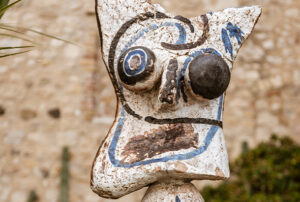
The museum is at the highest point of Antibes, the Grimaldi Castle, built on the ancient Greek acropolis (or citadel) of Antipolis. Picasso used the building as his studio for a few months in 1946, and when he bid farewell to Antibes, he left behind 23 paintings and 43 sketches. These have become the nucleus of an astonishing collection of sketches, ceramics, and full-scale paintings. Among my favorites (surprise, surprise) are a series of still lifes of fish, squid, and urchins inspired by his meals down by the port.
Picasso isn’t the only artist represented in the museum, and for my money the most striking of all the works here is Russo-French painter Nicolas de Staël’s Le Concert, a thrilling abstraction of a piano and a double bass against a crimson background that occupies an entire gallery wall. You can almost hear the music while gazing upon it. De Staël left the canvas unfinished, as open to the breeze and sunlight as Antibes, which I can’t help but think is refreshingly modern—until I learn that he was wracked with depression and died by suicide at age 41, leaving the unfinished painting (and a family) behind. Not for the first time, I wonder if the sea and sun beckon artists and writers not because they are carefree but because they seek relief from their demons.
Still in a philosophical mood, I head down to the water for a walk along the jagged coast’s Tirepoil Trail, so called because the oceanic gusts send one’s hair aflutter. (Tirepoil means hair-pulling.) The 3.1-mile trail begins at the Cap d’Antibes and ends at the white sands of Garoupe Beach. For centuries, this tiny strip of land was controlled by the wealthy owners of the waterside villas here, but according to the Littoral Law the footpath now belongs to the public. As I climb the narrow set of stairs, I take in the sea, in its varying shades of blue, to my left; to my right are villas with high gates, discreet cameras, and the occasional guard dog, forming a beautiful but impenetrable wall of privilege. If I had to choose, I’d make like Yves Klein and take the infinity of the sky over even the grandest villa.
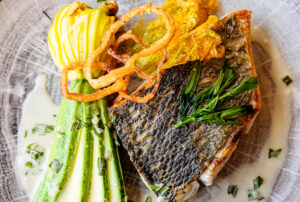
Ravenous after my hike, I head out the city gates to Port Vauban for dinner. There are plenty of Irish bars and English pubs here, catering to the international crews who live in crash houses and work the multimillion-dollar yachts moored in the marina, but I choose the charming Bistrot Margaux, where well-heeled locals enjoy archly traditional fare. The restaurant’s tagline is “Cooking the way it used to be,” and if my dinner—locally caught corvina, crispy-skinned yet succulent, with a tarragon sauce and a light fig mousse for dessert—is any indication of how things used to be, it’s no wonder that, in Fitzgerald’s words, we beat ceaselessly back to it.
Back at the Hôtel Belles Rives, I stretch myself out in the warm evening air on the extraordinary terrace and watch the sky change from blue into a dazzling show of rose, gold, crimson, and violet. Sipping a Safran Smash, an elaborate gin-based cocktail from the hotel’s Piano Bar Fitzgerald, I listen to the ivory-keyed notes dance and disappear into the air. I open the book I’ve brought with me: Tender Is the Night, and in this case, it’s perfect too.

Day 3
Getting pampered and channeling James Bond in Monaco
I could zoom from Antibes to Monaco on the A8 in less than an hour. Or, because this is the most beautiful stretch of coastline in the world, I could hug the shore on Le Corniche Inférieure, less poetically known as the D6098. Obviously, I choose the latter. Corniche means cliff road, and there are three scenic ones on this coast: the Grand Corniche, built by Napoleon atop an ancient Roman route about 500 meters above sea level; the Moyenne Corniche, built in the 20th century and winding through villages about 460 meters up, and the Corniche Inférieure, which was built by the Prince of Monaco in the 18th century right along the water.
With the sea on my right, I cruise past Villefranche-sur-Mer and Éze-sur-Mer, marveling at how the land seems stuck in time. I pass the Téte de Chien, a village on the dazzling promontory that separates France from Monaco, and feel as if I, too, am sliding back into the past. By the time I pull up to the Casino de Monte-Carlo, with its elaborately landscaped gardens full of exotic plants and waterfalls, I think I’ve landed in a fairy-tale kingdom. This country of just under 40,000 people is so small I can stand on my balcony at the Hôtel de Paris Monte-Carlo and see its borders. It’s owned by Albert II, Prince of Monaco, who is, according to many Monégasques, a really nice guy. He was a camp counselor on Lake Winnipesaukee in New Hampshire, went to Amherst, inherited a country. You know how it is. For someone like me, who has never been in a functioning kingdom before, especially one where the prince isn’t an abstraction but an actual guy you might catch a glimpse of strolling in the central plaza in front of the casino, the feeling of being in a fantasy is complete.
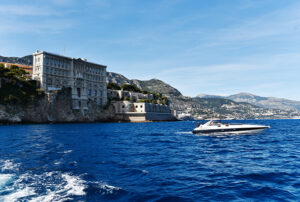
The entire kingdom is nestled between mountains and sea, and what it lacks in area it makes up for in vertical climb. I set out to explore, my first destination being the Villa Paloma, one of the many museums of Monaco. Some are devoted to the prince’s classic car collection, others to mammoth bones, naval history, stamps, or coins. This one is a contemporary art gallery in a mansion high on the hill. To get there, I start winding my way up and out of the town center.
Almost instantly, the glitz of Monte Carlo quiets into a charming, if compact, town. Houses crowd the switchbacks while (spotless) public elevators whisk pedestrians up the side of the mountain. I amble through gardens— there are many—pausing to watch a kindergarten class in bright vests play among the centuries-old olive trees in Princess Antoinette Park. Continuing up endless sets of stairs, I periodically turn around to see the Mediterranean stretched out behind me. Eventually, the houses become villas, and one of these is the Villa Paloma.
I find no fault in the exhibition, but the sun is bright, the sky is clear, and I yearn to be outside. It’s back to the port, then, this time via elevator. My next eight hours are going to be all James Bond–style opulence, so first I go looking for a reality check among the real Monégasque. I find just that with a simple plate of roast pork and ratatouille at Rôtisserie de Monaco, a vendor at the Condamine Market, which has been operating since 1880.
The Casino de Monte-Carlo, on the other hand, was built in 1893 by Charles Garnier, the architect of the Paris Opera. It’s known for its thermal spa—open to the public but with a private entrance for hotel guests—carved into the rock beneath the casino. I enter through the marble lobby, change into a swimsuit, bathrobe, and slippers, and soon find myself with scores of other relaxed people swimming about in a heated saltwater pool. I frolic. I crawl. I drink a smoothie. If this is what living under a prince is like, I’m all for it.
As evening nears, I return to my room and slide into the one crumpled suit I packed. It’s hard not to feel like 007 climbing the marble steps past the onyx columns into the casino. (The only question is, which Bond am I? Sean Connery in Never Say Never Again or Pierce Brosnan in GoldenEye? Both were shot here.) And it’s hard not to feel the thrill of something slightly illicit and maybe dangerous as, padding gently on the scarlet carpet in the main gaming area, I see vast sums of money exchanging hands.
I try to channel Bond’s confidence, but never before have I felt more a stranger in a strange land than in this wainscot-and-chandelier sanctum of wealth. Not wishing to put my meager life savings at risk, I pass through the casino’s gaming rooms to the restaurant, Le Salon Rose, for dinner. Is it a gamble to get wonton soup? Perhaps. Is it delicious? Definitely. Maybe I’m good at betting after all.
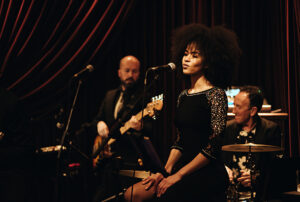
After dinner I walk over to the Bar Américain and see, to my delight, a band playing Patti Smith’s “Because the Night.” The bar is pretty empty, but there’s a guy ordering vodka and singing along loudly. The only words he knows are, “Because the night belongs to lovers,” but he sings them with verve. Now this is my kind of place.
Tonight, the band is a five-piece, headed up by Stefano Re, called Six in the City. I, as one does in Monaco, immediately fall in love with the lead singer, a half-Liberian, half-Italian woman named Cristiana, who tells me they’re based near Milan and regularly play the resorts here. I order a dirty martini and settle in at the bar to take in the Jazz Age luxury. The band begins a rousing rendition of 4 Non Blondes’ 1992 hit “What’s Up?” From behind me, I hear soprano voices warbling the chorus, cosmo glasses clinking. It turns out to be a trio of nurses in town from Chicago on an insurance junket. It’s well past midnight when we all get up and begin dancing. Together we sing in unison, asking each other gleefully, giddily, and perhaps glamorously, What’s going on? The answer, for me at least: the ultimate end to an amazing trip.
French Connection: Just in time for summer on the French Riviera, we’ve launched nonstop service from New York/Newark to Nice, France.
Next Up: Three Perfect Days: Amalfi Coast
